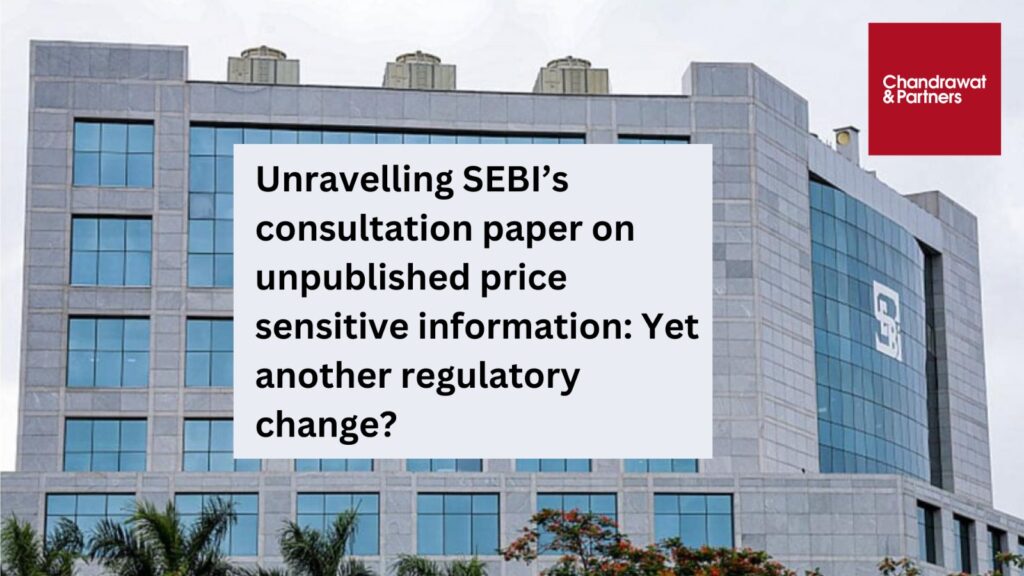Edit Content
Edit Content
Edit Content

Due to insufficient disclosures by Indian companies, it was deemed that material information under Regulation 30 of the SEBI (Listing Obligations and Disclosure Requirements) Regulations, 2015 (LODR Regulations), should be included within the scope of Unpublished Price Sensitive Information (“UPSI”). According to the Securities and Exchange Board of India’s (“SEBI”) most recent findings in its consultation paper dated 18 May 2023, only about 8% of information was classified as UPSI, leaving the majority of information outside of its purview and allowing companies to evade SEBI’s surveillance for suspected insider trading.
The purpose of including relevant information under Regulation 30 of the LODR Regulations within USPI is to dispel a major myth, i.e., that insider trading should be prohibited. As seen by the eight amendments the SEBI (Prohibition of Insider Trading) Regulations, 2015 have undergone in the previous three years, the regulator’s proactive approach to outlawing insider trading cannot be disregarded in this regard.
It’s important to note that the consultation paper undoes all of the progress made by the TK Viswanathan committee report. The paper appears to ignore the committee’s suggestion that substantial information covered by Regulation 30 of the LODR Regulations and UPSI cannot be regarded to be of a similar type and that many pieces of information fall outside the purview of UPSI.
It is asserted that the proposal to include relevant information under Regulation 30 within UPSI does offer the required transparency and prompt disclosure. The question of whether this consultation paper is an appropriate response or just another that falls by the wayside is raised by the numerous modifications that have been made to the legal situation since 2015, when it was originally introduced in India, to the present.
In a consultation paper dated May 18, 2023, SEBI proposed reviewing the definition of UPSI to bring consistency and clarity. In this sense, the proposal aims to connect the “material events” described in Regulation 30 of the LODR Regulations with the concept of UPSI.
If passed, this amendment will significantly affect the corporate regime since it will expand the scope of disclosures required by the Prohibition of Insider Trading Regulations. It is interesting to note that UPSI, as defined in Section 2(n) of the Prohibition of Insider Trading Regulations, serves as the foundation for every section of the regulations, so classifying any information under its purview would result in the company falling under their purview. Moreover, once a piece of information has been designated as UPSI, several requirements must be met:
The current situation is slightly uncertain. In uncommon instances, the Securities Appellate Tribunal has found that UPSI should not include relevant information. On the other hand, it has been noted in other sets of rulings that if a company considers any data to be material information, it must be disclosed and that, as a result, mere knowledge of the same will make it UPSI.
Examining what will be included in the expanded scope of UPSI under Regulation 30 is necessary. In this regard, List 3 of the LODR Regulations, which comprises Schedule 3, must be read with Regulation 30. Events or information included in Paragraphs A and B of Part A of Schedule III must be communicated to the exchange by Regulation 30. While Paragraph A of Part A includes information that is pertinent to shareholders and is therefore considered material and subject to disclosure, Paragraph B only mandates disclosure if the information complies with the entity’s materiality policy. Regarding the latter, SEBI published a consultation paper outlining a quantitative standard for disclosures, stating that the events’ threshold value must exceed 2% turnover, 2% net worth, or 5% of the three-year average profit or loss. This provides significant relief from SEBI’s discretion.
It will be interesting to see how material events and information are affected by UPSI. Given the frequent changes in the position, its success must be considered even though it would start a new era in the Indian insider trading regime.
A stronger regime will undoubtedly be implemented as a result of the proposed change, which was introduced to combat insider trading. This will eliminate any possibility of a material event or piece of information escaping UPSI’s control and, as a result, insider trading regulations. Thus, making sure that the companies have no chance to exploit the system’s flaws in any way.
The legislation, however, is not immune to some potential obstacles. The question of whether all of this information is of the UPSI kind becomes irrelevant due to its inclusion, notably under Paragraph A of Part A of Schedule III.
Numerous events, such as the appointment or dismissal of a share transfer agent or the results of an annual general meeting, may be informative, but they cannot be considered to have an impact on changes in scrip prices. The distinction between UPSI and material event/information under Regulation 30 becomes apparent at this point since the former has the potential to result in a major price change, whereas the latter does not. Therefore, the aforementioned action tends to overregulate and put relevant information under UPSI’s jurisdiction even when it is not. Additionally, if the information is classified as UPSI, all requirements under the Prohibition of Insider Trading regulations must be strictly followed, adding burden on companies and lengthening the process.
It is argued that although SEBI is correct to identify an issue, the approach it is taking needs some adjustment. To add clarity and predictability to the regulation’s text from a compliance standpoint, SEBI could introduce a description of the precise compliances that must be made.
For more information or queries, please email us at
[email protected]

Managing Partner
Copyright © Chandrawat & Partners. All Rights Reserved.
Copyright © Chandrawat & Partners. All Rights Reserved.

Chandrawat & Partners stands as a dynamic and rapidly expanding full-service firm, specializing in the delivery of exceptional professional and corporate services to a diverse clientele, both foreign and local. We proudly represent companies and individuals across a wide spectrum of sectors through distinct entities established in various countries worldwide.
ASIA
AFRICA
EUROPE
NORTH AMERICA
SOUTH AMERICA
OCEANIA
Chandrawat & Partners uses cookies to run our site and improve its usability.
By using our site you agree to our use of Cookies.